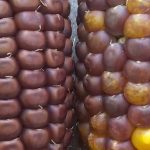Xiufang Hong: Plant Physiology First Author

 Xiufang Hong, first author of “Ascorbate peroxidase 1 allows monitoring of cytosolic accumulation of effector-triggered reactive oxygen species using a luminol -based assay”
Xiufang Hong, first author of “Ascorbate peroxidase 1 allows monitoring of cytosolic accumulation of effector-triggered reactive oxygen species using a luminol -based assay”
Current Position: Ph.D candidate in Plant Pathology, Zhejiang University
Education: Bachelor of Plant Sciences & Technology, Huazhong Agricultural University
Non-scientific Interests: Music and traveling
Brief bio:
After graduating from Huazhong Agricultural University with a bachelor’s degree in 2018, I was honored to join the group of Prof. Yan Liang, Zhejiang University. During my PhD studies, I mainly focused on investigating the molecular mechanism underlying the regulation of the long-lasting ROS burst in plant immunity. In this study, we first performed a forward genetic screen and isolated Arabidopsis mutants called delt4 that exhibited abolished sustained ROS production after LPS treatment. Based on the combination of Map-based cloning and whole genome sequencing, we found that the delt4 phenotype was indeed caused by the mutation in APX1 encoding a cytosolic ascorbate peroxidase. Using different ROS detection methods, we found that the peroxidase not only acts as an antioxidant to regulate intracellular redox homeostasis, but also catalyzes luminol oxidation and allows monitoring of the kinetics of cytosolic long-lasting ROS. Furthermore, we revealed that the sustained ROS induced by the effector of avirulent bacteria are eventually accumulated in the cytosol with the use of fluorescent dyes. This study sheds light on the novel function of cytosolic ascorbate peroxidase and also provides important insights into the spatial dynamics of ROS accumulation in plant immunity.
第一作者:洪秀芳
当前职位:浙江大学农业与生物技术学院植物病理学在读博士生
教育经历:
2018/09-至今,浙江大学,植物病理学,直博
2014/09-2018/06,华中农业大学,植物科学与技术专业,学士
兴趣爱好:听音乐,旅行
个人简介:
本人于2018年毕业于华中农业大学,获农学学士学位,同年有幸进入浙江大学梁岩老师课题组攻读直博生,主要从事植物免疫系统中持续型活性氧调控的分子机制研究。该研究首先通过正向遗传学的方法筛选了细菌脂多糖处理后持续活性氧迸发缺陷的拟南芥突变体delt4,通过图位克隆和全基因组测序发现其胞质抗坏血酸过氧化物酶APX1突变。借助不同的活性氧检测手段,我们发现该过氧化物酶不仅作为抗氧化剂调控胞内氧化还原稳态,还可催化化学发光剂鲁米诺的氧化发光,从而使鲁米诺可以监测胞内持续型活性氧的迸发动态。此外,结合荧光染料的方法,我们揭示了病原细菌无毒菌株效应子诱导产生的活性氧最终在植物细胞胞质内积累。该研究阐明了抗坏血酸过氧化物酶的新功能,也为植物免疫中活性氧积累的空间动力学提供了重要的见解。



